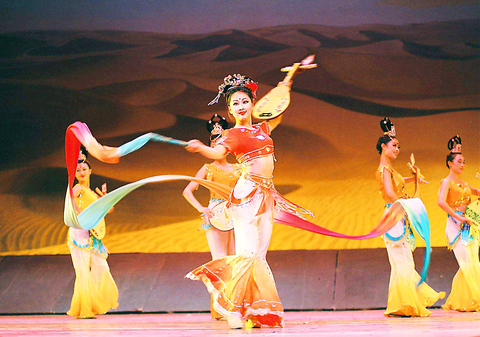From the heart of the Gobi desert, the Gansu Dunhuang Art Theater brings a classic of Chinese ballet, Flower Rain on the Silk Road, to Taiwan for a week-long tour of the island.
The tour began last night at Taipei's Sun Yat-sen Memorial Center and will play again tonight in Banqiao.
Dunhuang lies at a crucial junction on the Silk Road, the ancient tangle of trails that stretch more than 7,000km from China to the Mediterranean and served as a highway for trading merchandise and mixing cultures: Chinese, Indian, Islam and Greek. By the 4th century , the road had made Dunhuang prosperous. It also made it an important stop for Buddhists and a destination for thousands of Buddhist monks from India.

PHOTO COURTESY OF ARS FORMOSA
Today, the best-known representatives of that time are the Mogao Caves, hundreds of shrines cut into a long cliff face some 25km outside the city. Monks began carving the caves in 366 AD and, in each of them, made intricate drawings and clay stuccoes of the Buddha as well as murals depicting the lives and cultures of the people who came to Dunhuang.
The site began to decline in the 12th century and slipped into obscurity until the 20th century. Of the thousands of caves carved by monks, nearly 500 remain.
The world-famous murals are the inspiration for Dunhuang Charm, with scenes from the cave walls coming to life on stage. The scenery and costumes, too, reflect the rich design and vibrant colors found in the Mogao Caves.
Flower Rain on the Silk Road was first performed in 1979 and has since become one of the most-staged ballets in the world. In 1982, the Gansu Dunhuang Art Theater had the honor of performing the ballet in Italy, a stage that helped launch the ballet's popularity around the globe. It's now been staged thousands of times both in and outside of China.
Songs like The Iraqi State (
Performance notes:
What: Dunhuang Charm, Flower Rain on the Silk Road
Time and place:
March 25: Taipei County Government Multi-purpose Hall, 3F, 161 Zhongshan Rd., Sec. 1, Banqiao, Taipei County (板橋市中山路一段161號3F).
March 26: Changhua County Yunlin Performing Arts Center.
March 27: Tainan City Cultural Center.
March 28: Tainan County Cultural Center.
March 29: Chiayi City Cultural Center Performing Arts Auditorium.
March 30: Kaohsiung City CKS Cultural Center Auditorium.
March 31: Taichung City Chungshan Hall.
Tickets: Cost from NT$300 to NT$1,200, depending on location. Contact Ars Formosa at (02) 2771 5676 or visit Web site at www.arsformosa.com.tw.

In the March 9 edition of the Taipei Times a piece by Ninon Godefroy ran with the headine “The quiet, gentle rhythm of Taiwan.” It started with the line “Taiwan is a small, humble place. There is no Eiffel Tower, no pyramids — no singular attraction that draws the world’s attention.” I laughed out loud at that. This was out of no disrespect for the author or the piece, which made some interesting analogies and good points about how both Din Tai Fung’s and Taiwan Semiconductor Manufacturing Co’s (TSMC, 台積電) meticulous attention to detail and quality are not quite up to

April 21 to April 27 Hsieh Er’s (謝娥) political fortunes were rising fast after she got out of jail and joined the Chinese Nationalist Party (KMT) in December 1945. Not only did she hold key positions in various committees, she was elected the only woman on the Taipei City Council and headed to Nanjing in 1946 as the sole Taiwanese female representative to the National Constituent Assembly. With the support of first lady Soong May-ling (宋美齡), she started the Taipei Women’s Association and Taiwan Provincial Women’s Association, where she

Chinese Nationalist Party (KMT) Chairman Eric Chu (朱立倫) hatched a bold plan to charge forward and seize the initiative when he held a protest in front of the Taipei City Prosecutors’ Office. Though risky, because illegal, its success would help tackle at least six problems facing both himself and the KMT. What he did not see coming was Taipei Mayor Chiang Wan-an (將萬安) tripping him up out of the gate. In spite of Chu being the most consequential and successful KMT chairman since the early 2010s — arguably saving the party from financial ruin and restoring its electoral viability —

It is one of the more remarkable facts of Taiwan history that it was never occupied or claimed by any of the numerous kingdoms of southern China — Han or otherwise — that lay just across the water from it. None of their brilliant ministers ever discovered that Taiwan was a “core interest” of the state whose annexation was “inevitable.” As Paul Kua notes in an excellent monograph laying out how the Portuguese gave Taiwan the name “Formosa,” the first Europeans to express an interest in occupying Taiwan were the Spanish. Tonio Andrade in his seminal work, How Taiwan Became Chinese,